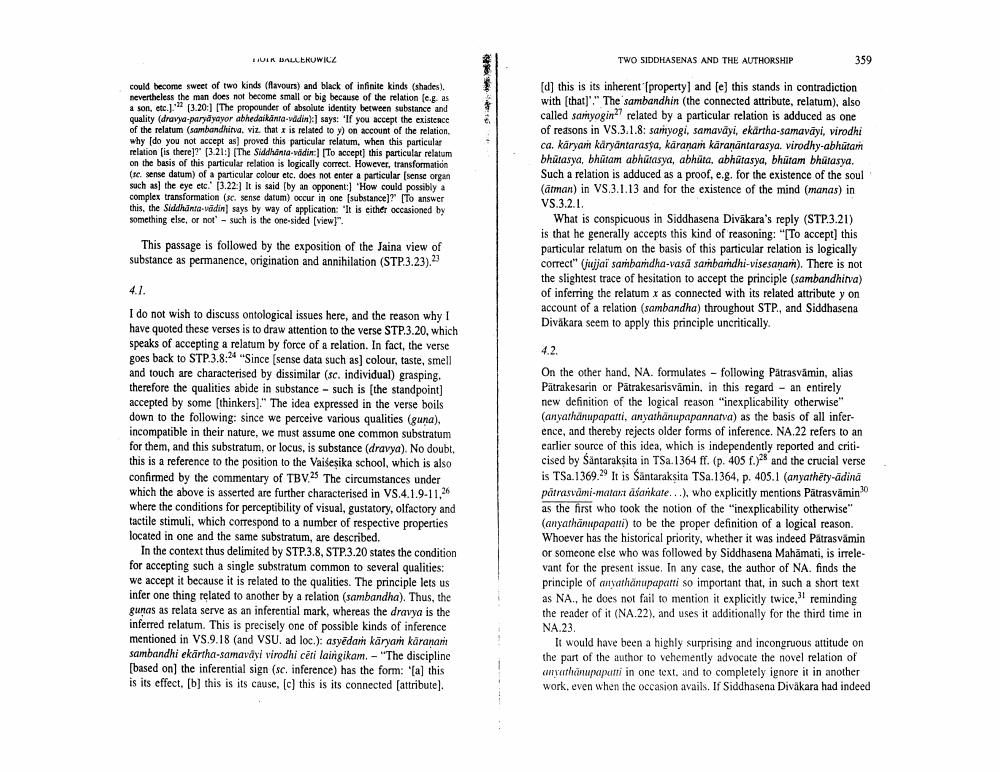Book Title: Two Siddhasenas And Authorship Of Nyayavatara And Sammati Tarka Pprakarana Author(s): Piotr Balcerowicz Publisher: Piotr Balcerowicz View full book textPage 5
________________ HUIR DALLEROWICZ TWO SIDDHASENAS AND THE AUTHORSHIP 359 . could become sweet of two kinds (flavours) and black of infinite kinds (shades). nevertheless the man does not become small or big because of the relation (e.g. as a son, etc.). (3.20: The propounder of absolute identity between substance and quality (dravya-paryayayor abhedaikanta-vddin):) says: 'If you accept the existence of the relatum (sambandhita, viz. that is related to y) on account of the relation why [do you not accept as proved this particular relatum, when this particular relation is there)? (3.21:) (The Siddhantawidin: To accept this particular relatum on the basis of this particular relation is logically correct. However, transformation (se sense datum) of a particular colour etc. does not enter a particular (sense organ such as the eye etc. [3.22] It is said (by an opponent:) "How could possibly a complex transformation (sc. sense datum) occur in one (substance)? [To answer this, the Siddhanta din says by way of application: 'It is either occasioned by something else, or not-such is the one-sided [view]". [d] this is its inherent property and (e) this stands in contradiction with (that)'." The sambandhin (the connected attribute, relatum), also called saryogin27 related by a particular relation is adduced as one of reasons in VS.3.1.8: sariyogi, samaväyi, ekartha-samaväyi, virodhi ca. karyan karyantarasya, karanam karanāntarasya. virodhy-abhūtam bhūtasya, bhätam abhūtasya, abhūta. abhūtasya, bhūtam bhutasya. Such a relation is adduced as a proof, e.g. for the existence of the soul (arman) in VS.3.1.13 and for the existence of the mind (manas) in VS.3.2.1. What is conspicuous in Siddhasena Divakara's reply (STP.3.21) is that he generally accepts this kind of reasoning: "[To accept this particular relatum on the basis of this particular relation is logically correct" ujjai sambandha-vasa sambaridhi-visesanam). There is not the slightest trace of hesitation to accept the principle (sambandhitva) of inferring the relatum x as connected with its related attribute y on account of a relation (sambandha) throughout STP., and Siddhasena Divakara seem to apply this principle uncritically This passage is followed by the exposition of the Jaina view of substance as permanence, origination and annihilation (STP.3.23). 4.1. 4.2. I do not wish to discuss ontological issues here, and the reason why I have quoted these verses is to draw attention to the verse STP.3.20, which speaks of accepting a relatum by force of a relation. In fact, the verse goes back to STP.3.8:24 "Since (sense data such as) colour, taste, smell and touch are characterised by dissimilar (sc. individual) grasping, therefore the qualities abide in substance - such is the standpoint) accepted by some thinkers." The idea expressed in the verse boils down to the following: since we perceive various qualities (guna), incompatible in their nature, we must assume one common substratum for them, and this substratum, or locus, is substance (dravya). No doubt. this is a reference to the position to the Vaisesika school, which is also confirmed by the commentary of TBV2 The circumstances under which the above is asserted are further characterised in VS.4.1.9-11, where the conditions for perceptibility of visual, gustatory, olfactory and tactile stimuli, which correspond to a number of respective properties located in one and the same substratum, are described. In the context thus delimited by STP.3.8, STP.3.20 states the condition for accepting such a single substratum common to several qualities: we accept it because it is related to the qualities. The principle lets us infer one thing related to another by a relation (sambandha). Thus, the gunas as relata serve as an inferential mark, whereas the dravya is the inferred relatum. This is precisely one of possible kinds of inference mentioned in VS.9.18 (and VSU. ad loc.): asyedar karyan karanan sambandhi ekārtha-samavayi virodhi cēti lainigikam. -"The discipline [based on the inferential sign (sc. inference) has the form: (a) this is its effect, (b) this is its cause. (c) this is its connected (attribute]. On the other hand, NA. formulates - following Patrasvămin, alias Pätrakesarin or Pátrakesarisvämin, in this regard - an entirely new definition of the logical reason "inexplicability otherwise" (anyathinupaparti, anyathanupapannava) as the basis of all inference, and thereby rejects older forms of inference. NA.22 refers to an earlier source of this idea, which is independently reported and criticised by Säntaraksita in TSa. 1364 ff. (p. 405 1.) and the crucial verse is TSa. 1369.29 It is Santaraksita TSa.1364, p. 405.1 (anyathēty-ādina påtrasveimi.malastasankate...), who explicitly mentions Pätrasvamin as the first who took the notion of the "inexplicability otherwise (anyathanupapani) to be the proper definition of a logical reason. Whoever has the historical priority, whether it was indeed Patrasvamin or someone else who was followed by Siddhasena Mahamati, is irrelevant for the present issue. In any case, the author of NA. finds the principle of anyathanupaparti so important that, in such a short text as NA., he does not fail to mention it explicitly twice, reminding the reader of it (NA.22), and uses it additionally for the third time in NA.23. It would have been a highly surprising and incongruous attitude on the part of the author to vehemently advocate the novel relation of arvathanuppunti in one text, and to completely ignore it in another work, even when the occasion avails. If Siddhasena Divakara had indeedPage Navigation
1 ... 3 4 5 6 7 8 9 10 11 12 13 14
